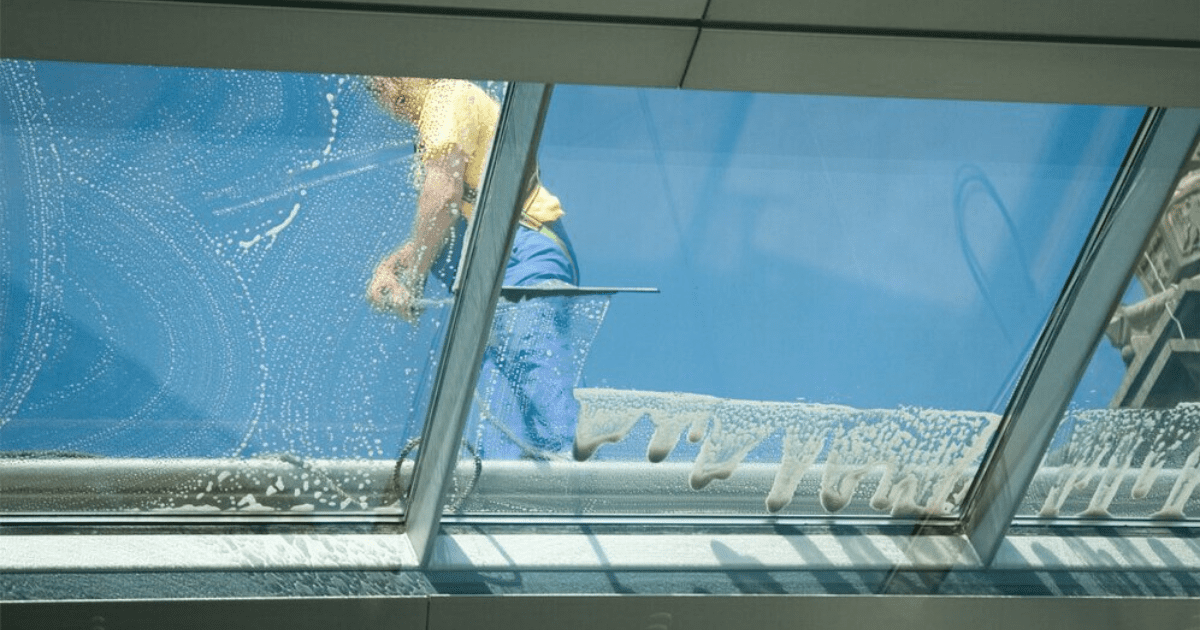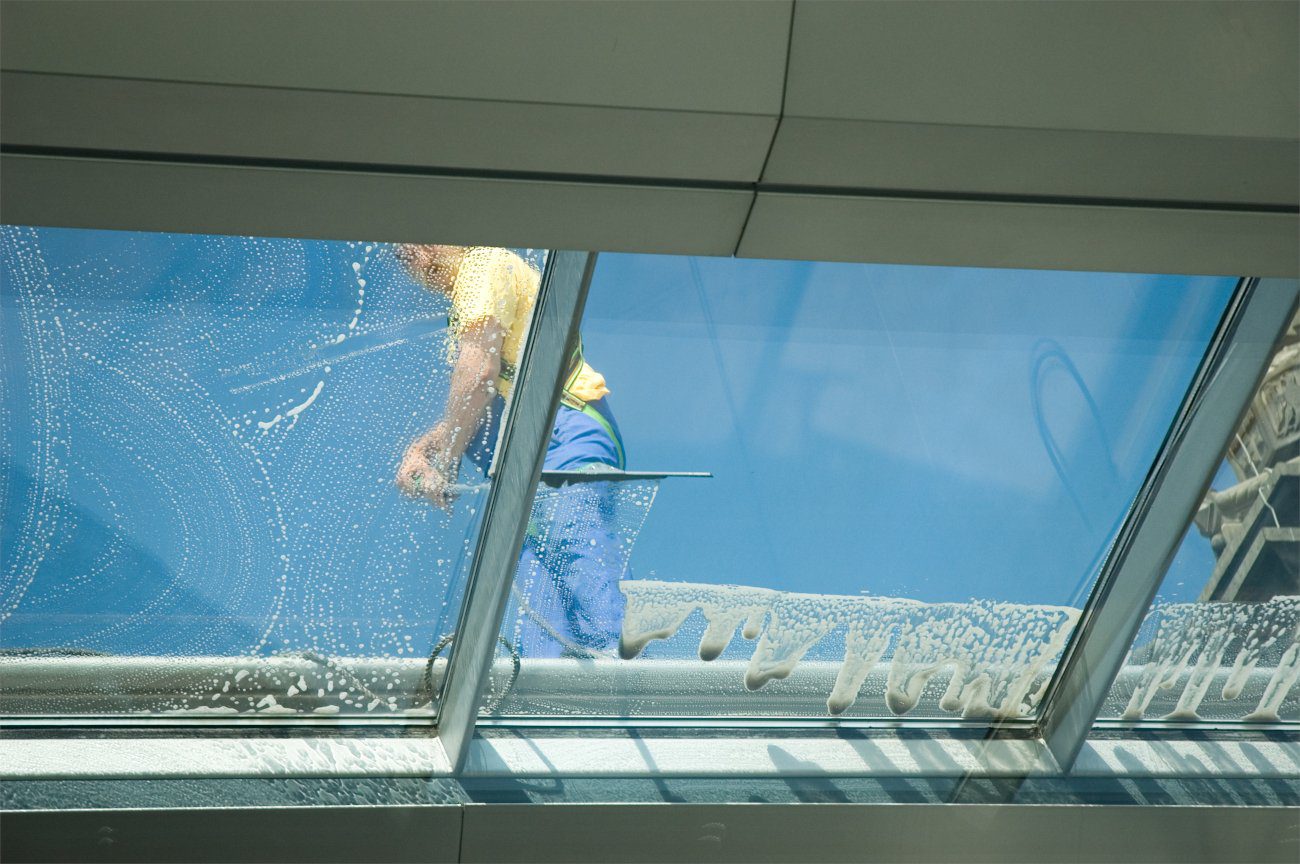Skylights are a great addition to a home for their aesthetics, energy efficiency, and natural lighting and heating which is why many people decide to install skylights. One thing everyone should think about when deciding to get a skylight is the maintenance and cleaning of a skylight as these need to be done often and can be quite labour-intensive. We will go over some tips and tricks on how to clean your skylights most efficiently and a step-by-step walkthrough on how to clean them.
What you will need.
Firstly, two parts of the skylight will need cleaning the inside and outside of the skylight so you will need a few things to clean the skylight effectively mainly a ladder (or skylight cleaning pole or a broom/mop handle and string), clean rags/dishcloth/cleaning cloths, warm water, dish soap, a bucket, white vinegar, towels/tarp and some safety equipment like non-slip shoes and a safety harness that can attach to a point on your roof. Now while that may seem like a lot depending on the position of the skylight you may not need all of these, but this should be everything needed regardless of the individual circumstances.
Precautions to take.
Make sure not to use any abrasive cleaners or cleaners with ammonia as these can damage the skylight’s protective coating. When cleaning the inside of the skylight, move any furniture underneath it and put down a plastic tarp or some towels, if possible, to catch any debris or water that will fall off the skylight. Rain will help keep the outside of the skylight clean while the wind will help keep debris off the skylight, but it is still best to clean it often.
Cleaning the interior side of the skylight, step by step.
So, let’s go over how to clean your skylight.
-
Create your cleaning solution, mix a few drops of dish soap in warm water
-
Setup your ladder under the skylight if it’s out of reach or wrap and tie a clean rag/dishcloth to a long handle of a broom or mop
-
Gently wipe the skylight with a dry cloth to remove any dust or debris from the skylight
-
Now wet a clean cloth with the cleaning solution and wipe down the skylight like any other window
-
If there are any tough grim stains that the soap water didn’t clean up mix up some white vinegar and warm water in about 1:2 ratio and try again to remove the grim if that doesn’t work add more vinegar
-
If used vinegar mixture use normal soap water again to wipe away any of the remaining vinegar mixtures
-
Wipe dry with a dry cloth
Cleaning the external face of the Skylight.
For the outside of the skylight, you may need to work over your roof, or you may be able to reach from a ladder, this is the more dangerous task so if you are not comfortable doing this getting a professional to clean the outside of the skylight is the best method. If you are cleaning the outside of the skylight yourself, follow the same step as for the inside but be sure to remove any built-up debris that could have built up around the frame of the skylight and in the joins of the skylight and roof. After cleaning the skylight rinse with a hose instead of drying as it will dry naturally with no issues.
………………………..
Title: How to clean a skylight
Sourced From: www.simplygenuine.com.au/how-to-clean-a-skylight
Published Date: Tue, 15 Mar 2022 22:10:02 GMT
Frequently Asked Questions
What is the life expectancy of a skylight
A skylight’s life expectancy depends on its material and whereabouts. It also needs to be maintained properly. A typical skylight will last between ten and thirty years if it is properly maintained.
Skylights are usually made from high quality materials such as acrylic or PVC and can last up to 15 years if they are properly maintained. They can also be made of steel, tempered glass, or wood frames. While each material has its own longevity, they all have the potential to provide long-lasting structural integrity if properly maintained.
A skylight’s durability will depend on the quality of its materials and the location it is placed. You might find that they don’t last as long in places with extreme temperature or humidity. The performance and life expectancy of the device can be affected by windblown debris or high ultraviolet radiation.
Skylights can offer wonderful natural lighting options in homes for many decades if they’re properly maintained. This lifespan could vary depending on factors like material type, geographic location and regular upkeep.
What is your average cost for a tubular Skylight?
Average tubular skylights cost $200-$1000 depending on their size, light output, and energy efficiency. Your tubular skylight is more efficient the more money you spend. Although larger sizes are generally more expensive than smaller skylights in general, this is not always the case.
Shopping around for various brands and types of tubular skylights is the best way to find out what a fair price is. There are many material options available for products such as these. Some can be more expensive than others, but they offer higher energy efficiency. An online retailer might be a good choice if you are looking for a tubular skylight with discounts or free shipping.
You should consider the climate of your house when buying a tubular skylight. Are you exposing it to high temperatures and high humidity? If the product is not right, this could lead to permanent damage or even decrease in its effectiveness. If you need to, ensure that the product is suitable for harsh environments.
The cost of professional installation will be higher but it will ensure that it’s done right. Even lower-cost models can leak easily due to poor installation. It may be worth the extra expense to avoid any future problems.
What’s the difference between a sun tunnel and a solar tube?
Solar tubes and suntubes both bring natural light to dark areas in homes. Despite their similar appearances and serving the same purpose, they have distinct differences.
The outer dome of a solar tube sits on your roof. The inner tube passes through your attic, or other enclosed space to provide the required lighting effect. The inner tube contains a highly reflective surface to amplify the sunlight’s reflection and is often insulated, which helps contain energy throughout the day and night. The outer dome connects directly and easily to shingles.
The sun tunnel, also known as a tubular skylight or sun tunnel, uses a different approach. This is a single tube that has an acrylic dome attached to the end. The end at the outside leads into your chosen room. If the installation goes well, homeowners will be able to enjoy a uniform and efficient indoor lighting solution. Sun tunnels are gaining popularity due to their visual appeal and ease of use.
The main difference between a Sun Tunnel and a Solar Tube is that the former provides more insulation due to its reflective interior surface. While sun tunnels are less expensive, they still provide great natural light indoors. Sun tunnels also require less material, and are much easier to install than traditional Skylights. These sun tunnels may be the best choice for anyone who wants minimal effort in home improvement projects.
Is it possible to see the sky through a Sun Tunnel?
Sun Tunnel or also called a solar tube is a cylindrical skylight which acts like a light shaft to bring natural sunlight into interior rooms and living spaces. They consist of a reflective tunnel network that connects the roof with an interior ceiling mounted diffuser.
So can you see the sky through a sun tunnel? It depends. It all depends on where your sun tunnel is located. In most cases where sun tunnels have been installed, such as near buildings or walls, the surrounding environment can block views.
Sun tunnels can fill your living areas with natural light and provide great views without the need to block any outdoors. A typical 10″ sun tunnel will extend to 20ft down the reflective tube. After that, it forms a 360deg spread onto the ceiling. This spread helps reduce glares as well as illuminating the space thoroughly. These are great for accent lighting, providing continuous daylighting in all interior spaces.
What are some of the drawbacks of sun tunnels
Sun tunnels (also known as light tube) are a type a tunnel that uses natural sunlight to draw in and direct it into a living space. Although sun tunnels offer many great benefits like energy savings and improved lighting quality they also have their drawbacks.
Sun tunnels are vulnerable to heat loss because they use direct pathways to transmit light into interior spaces. Sun tunnels are susceptible to heat loss in cold climates.
Sun tunnels can also cost a lot depending on the structure and size of your house. It requires cutting through walls which requires hiring skilled labor or doing the job yourself if you are comfortable with DIY projects. These tunnels can also be hard to maintain and repair if they become damaged over time. Sun tunnels depend so heavily on natural sunlight that they may not be as effective as they should be if there is insufficient daylight from nearby trees or at night.
Finally, depending on where you live, there might be laws regarding construction or zoning that limit your ability install a sun tunnel.
Statistics
- See more product details Special offers and product promotions to save up to 10% withCreate your FREE Amazon Business accountBusiness-only prices and free shipping. (amazon.com)
- 3 Brightness, IP65 Waterproof Shed Light Home, Garden, Patio 3.7 out of 5 stars 6% coupon applied at checkout save 6% with coupon 12 inches (amazon.com)
- This means you’ll get a 26% tax credit on the skylight and installation costs. (billraganroofing.com)
- 4.4 out of 5 stars 5% coupon applied at checkout save 5% with coupon 3 sizes3 sizes AHAWILL Modern Ceiling Light, Crystal Flush Mount LED Chandelier Ceiling Flower Lamp with Remote Control for Living Room, Bedroom, Hall, Dining Room (amazon.com)
- The Solar Night Light Kit makes the product and installation eligible for a 30% federal tax credit. (whyskylights.com)
External Links
tubular-skylight.com
whyskylights.com
holtsmithsonfoundation.org
solatube.com
- Solatube Tubular Skylights, Natural Lighting for Your Home
get.adobe.com
How To
Let Your Home Breathe: How To Properly Ventilate With Skylights
A home should be well ventilated to ensure it is comfortable, clean, and efficient. Poorly ventilated spaces can lead to higher energy costs, poor air quality and even health issues. Adding skylights to your home is a great way to bring in natural light while providing circulation and additional airflow throughout your space.
Skylights allow fresh air to flow through your home via a small channel. The warmer air rising will draw in cooler air from the outside through lower-level windows and doors. This allows for proper airflow, balances temperature levels and reduces noise or cost of ventilation systems.
Using skylights for ventilation provides many benefits for homeowners: improved indoor air quality due to increased fresh oxygen levels; reduced heating and cooling bills since there are fewer drafts or resistance on the system; improved comfort from warmer temperatures during colder months; even added natural light which improves mental well-being while mood-lifting hormones get produced naturally!
Properly sized skylights can be opened remotely with remote controls, so you can take advantage of the weather whenever it is possible. Make sure they’re placed appropriately based on their size relative to other windows or doors–this will give the best results regarding climate control and heating/cooling savings. The insulation around your skylight openings, or skylight itself, is important as it affects the heat flow into your house. When temperatures dip below freezing, you should always use storm windows to prevent drafts.

